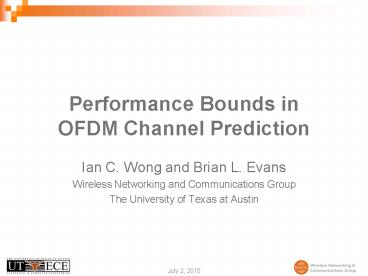Performance Bounds in OFDM Channel Prediction - PowerPoint PPT Presentation
Title:
Performance Bounds in OFDM Channel Prediction
Description:
Title: Slide 1 Author: Sande Storey Last modified by: Ian C. Wong Created Date: 10/7/2002 1:18:47 PM Document presentation format: On-screen Show Company – PowerPoint PPT presentation
Number of Views:96
Avg rating:3.0/5.0
Title: Performance Bounds in OFDM Channel Prediction
1
Performance Bounds inOFDM Channel Prediction
- Ian C. Wong and Brian L. Evans
- Wireless Networking and Communications Group
- The University of Texas at Austin
2
Adaptive Orthogonal Frequency Division
Multiplexing (OFDM)
- Adjust transmission based on channel information
- Maximize data rates and/or improve link quality
- Problems
- Feedback delay - significant performance loss
Souryal Pickholtz, 2001 - Volume of feedback - power and bandwidth overhead
3
Prediction of Wireless Channels
- Use current and previous channel estimates to
predict future channel response - Overcome feedback delay
- Adaptation based on predicted channel response
- Lessen amount of feedback
- Predicted channel response may replace direct
channel feedback
4
Previous Work
- Prediction on each subcarrier Forenza Heath,
2002 - Each subcarrier treated as a narrowband
autoregressive WSS process Duel-Hallen et al.,
2000 - Prediction using pilot subcarriers Sternad
Aronsson, 2003 - Used unbiased power prediction Ekman, 2002
- Prediction on time-domain taps Schafhuber
Matz, 2005 - Used adaptive prediction filters
- Applied to predictive equalization
5
Previous Work
- Comparison of prediction approaches using unified
framework Wong et al, 2004 - Time-domain approach gives best MSE performance
vs. complexity tradeoff - Prediction using high-resolution frequency
estimation Wong Evans, 2005 - Shown to significantly outperform previous
methods with same order of complexity - Key idea 2-step 1-dimensional frequency
estimation
6
Summary of Main Contributions
- Simple, closed-form expression for MSE lower
bound in OFDM channel prediction for any unbiased
channel estimation/prediction algorithm - Yields important insight into designing OFDM
channel predictors without extensive numerical
simulation - Simple, closed-form expression for MSE lower
bound in OFDM channel prediction using
2-step1-dimensional frequency estimation
7
System Model
- OFDM baseband received signal
- Perfect synchronization and inter-symbol
interference elimination by the cyclic prefix - Flat passband for transmit and receiver filters
over used subcarriers - Deterministic wideband wireless channel model
- Far-field scatterer (plane wave assumption)
- Linear motion with constant velocity
- Small time window (a few wavelengths)
8
Pilot-based Transmission
- Comb pilot pattern
- Least-squares channel estimates
9
Prediction as parameter estimation
- Channel is a continuous non-linear function of
the 4M-length channel parameter vector - Deterministic channel prediction premise
- Estimate parameters of channel model from the
least-squares channel estimates - 2-dimensional sum of complex sinusoids in white
noise - Extrapolate the model forward
10
Cramer-Rao Lower Bound (CRLB)
- CRLB for narrowband caseBarbarossa Scaglione,
2001 Teal, 2002 - First-order Taylor approximation
- Expensive numerical evaluations necessary
- Monte-Carlo generation of parameter vector
realizations - CRLB for function of parameters Scharf, 1991
11
Closed-form asymptotic MSE bound
- Using large-sample limit of CRLB matrix for
general 2-D complex sinusoidal parameter
estimation Mitra Stoica, 2002 - Much simpler expression
- Achievable by maximum-likelihood and nonlinear
least-squares methods - Monte-Carlo numerical evaluations not necessary
12
Insights from the MSE expression
Doppler frequency phase cross covariance
Amplitude phase error variance
Doppler frequency error variance
Time-delay phase cross covariance
Time-delay error variance
- Linear increase with ?2 and M
- Dense multipath channel environments are the
hardest to predict Teal, 2002 - Quadratic increase in n and k with f and ?
estimation error variances - Emphasizes the importance of estimating these
accurately - Nt, Nf, Dt and Df should be chosen as large as
possible to decrease the MSE bound
13
High-performance OFDM channel prediction
algorithm Wong Evans, 2005
- In wireless channels, a number of sinusoidal rays
typically share a common time delay - Proposed 2-step 1-D estimation
- Lower complexity with minimal performance loss
- Rich literature of 1-D sinusoidal parameter
estimation - Allows decoupling of computations between
receiver and transmitter
14
Asymptotic MSE Lower Bound for 2-step estimation
Amplitude phase error variance
Doppler frequency phase cross covariance
Doppler frequency error variance
Time-delay error variance
- Used asymptotic CRLB matrix for 1-D sinusoidal
parameter estimation Stoica et al., 1997 - Complex amplitude estimation error variance of
first step used as the noise variance in second
step - For large prediction lengths, i.e. large n
15
IEEE 802.16 Example
16
MSE vs. SNR, n500
17
MSE vs. n, SNR10 dB
18
Conclusion
- Derived simple, closed-form expressions for
- MSE lower bound for OFDM channel prediction
- Expensive numerical evaluation unnecessary
- Yields valuable insight into design of channel
predictors - Block lengths and downsampling factors should be
made as big as possible - Estimation of Doppler frequencies/time delays
very important - Dense multipath channels may not be predictable
- MSE Lower bound for 2-step OFDM channel
prediction - Small penalty compared to above bound
- Basis for a high-performance channel prediction
algorithm - Proposed 2-step 1-D prediction algorithm is close
to the lower bound































